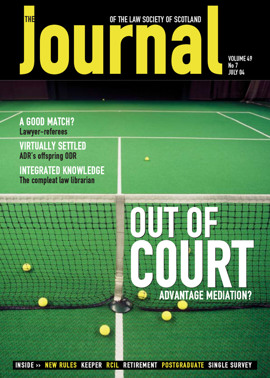Equality for the employed
Membership of the legal profession denotes a relationship of confidentiality, trust and confidence under the umbrella of the ability to provide independent advice free of coercion. It is important for the public at large as much as for the legal profession that that quality of independence and the relationship of confidentiality is secured, whether in the context of private practice or employed legal practice, and the In-House Lawyers’ Group heartily endorses these sentiments in the Law Society of Scotland’s response to the Clementi consultation.
The priority issue from an IHLG perspective is clearly equality, specifically in the areas of:
- a level playing field in terms of regulation of employed solicitors and private practitioners;
- professional privilege;
- movement within the legal community, which is not only an aspect of equality but vital to a healthy legal profession in a small country.
We must consider the needs of employed solicitors and their employers’ business requirements. The distinction in the consultation paper between LDPs and MDPs is correct, but in practice, the former is a regulatory matter: the management/ownership distinction is not likely to be such an issue as with MDPs, where there is a need to make a clear distinction between the services provided and the ownership of the business and to consider questions relating to public interest and public protection.
Provision of services is largely a market-led issue – from a competition perspective, businesses should be able to offer legal and other services. There could of course be dangers were large organisations permitted to operate unfair business practices. Cherry-picking lucrative practice areas could lead to a restriction of consumer choice were other providers offering a full range of legal services driven out of business as a result. The legal service element would require to be regulated appropriately and carefully within whatever regime was to be applied. The lessons of Enron and World.com must be remembered and appropriate safeguards put in place. Other services may or may not be regulated: if a business offers legal services, regulation for that element would be required, but for, say, shoe repairs, then apart from health and safety etc there would be no requirement for regulation and success would be determined by the market. This is the now familiar approach of the FSA scheme whereby regulation only applies in respect of financial services which fall within the FSA’s regulatory remit.
Lawyers should be able to access capital in a cost-effective manner. This may involve direct investment in business; similarly other businesses should be able to invest in the provision of legal services. Behind the Clementi Review lies the issue of consumer choice and the cost-effective provision of legal services.
The FSA assesses the fitness of those involved in the provision of financial services by authorising institutions to carry on business as a financial institution and individuals to undertake certain types of financial services work, and identifying and then regulating key players in the business, through the “approved persons” regime. This approach could be applied to regulate non-lawyer investors/owners.
The model of FSA regulation does have its negative features. Rightly or wrongly the FSA is perceived to be extremely bureaucratic and to have been ineffective in securing consumer protection in cases like endowment mis-selling. This perception and its causes would have to be carefully addressed.
Many public organisations and commercial businesses will continue employing specialist in-house lawyers. It is essential that such bodies are not deterred from doing so by the imposition of unnecessary regulatory costs or bureaucracy. Any new regulatory regime should include exemptions for lawyers who do not handle clients’ funds or provide legal advice to persons other than their employer, whilst ensuring that such exemptions should not constitute any barrier to inhibit in-house lawyers transferring either into traditional private practice or to the new LDPs and MDPs. There are of course analogous precedents for this in the Financial Services and Markets Act 2000.
The only reference in the Review to the issue of MNPs is contained as a subparagraph of Chapter F, “International Dimensions”. This issue merits more attention. MNPs should be addressed. Unless cross border restrictions on the provision of legal services are dealt with, any benefits from regulatory changes will be restricted.
The In-House Lawyers Group and the mainstream profession work comfortably together. Each recognises the other’s strengths and skills. In-house teams require occasionally to seek specialist advice from the private sector, and the private sector is well aware of the high level skills and knowledge required for a successful in-house team. Working practices such as loose “partnering” with firms and the secondment of staff have gone far to ensure that good working relationships can be forged for the benefit of the profession, business and the public as a whole. While there are differences, these are more a question of degree than substance.
In this issue
- Pushing ahead with a modernising agenda
- Equality for the employed
- Break point
- The devil in the detail
- The work goes on
- Identity crisis
- The lawmen in black
- Degrees of insight
- Image and reality
- Terminal settlement
- The informed client
- Counting down
- Speaking for the firm
- Does the EU Regulation work?
- Power to the people?
- Website reviews
- Book reviews
- New build: getting the loan funds
- Keeper's Corner
- RCIL and community rights






